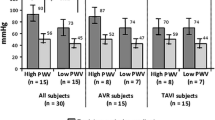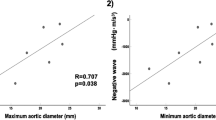Abstract
Purpose
Pulse wave velocity (PWV), which measures vascular stiffness, is a powerful predictor of cardiovascular event. Treatment of aneurysms with endovascular prosthesis has been reported to increase PWV. The purpose of this study was to evaluate whether an endoskeleton stent graft design has less effect on PWV than the exoskeleton stent graft design.
Methods
Between July 2008 and September 2016, 74 patients underwent endovascular treatment of aortic arch aneurysm in our institution. PWV before and after surgery were compared between those who underwent treatment with Najuta, an endoskeleton stent graft (n = 51), and those treated with other commercially available exoskeleton stent grafts (n = 23).
Results
Preoperative PWV (endoskeleton: 2004 ± 379.2 cm/s vs. exoskeleton: 2083 ± 454.5 cm/s, p = 0.47) was similar between the two groups. Factors that were associated with preoperative PWV were age (r = 0.37, 95% CI 0.15–0.56, p = 0.002) and mean arterial pressure (r = 0.53, 95% CI 0.34–0.68, p < 0.001). There was a significant increase in PWV in patients treated by exoskeleton stent grafts (before: 2083 ± 454.5 cm/s vs. after: 2305 ± 479.7 cm/s, p = 0.023) while endoskeleton stent graft showed no change in PWV (before: 2003 ± 379.2 vs. after: 2010 ± 521.1, p = 0.56). In a multivariate analysis, mean arterial pressure (coef 17.5, 95% CI 6.48–28.59, p = 0.002) and exoskeleton stent graft (coef 359.4, 95% CI 89.36–629.43, p = 0.010) were independently associated with PWV after surgery.
Conclusions
Physiological changes after endovascular treatment should be considered including effect on vascular stiffness. Endoskeleton stent graft may provide aneurysm repair with minimum effect in PWV after surgery.

Similar content being viewed by others
References
Bengtsson H, Sonesson B, Bergqvist D. Incidence and prevalence of abdominal aortic aneurysms, estimated by necropsy studies and population screening by ultrasound. Ann N Y Acad Sci. 1996;800:1–24.
Zieman SJ, Melenovsky V, Kass DA. Mechanisms, pathophysiology, and therapy of arterial stiffness. Arterioscler Thromb Vasc Biol. 2005;25:932–43.
Fok H, Cruickshank JK. Future treatment of hypertension: shifting the focus from blood pressure lowering to arterial stiffness modulation? Curr Hypertens Rep. 2015;17:569.
Guo X, Lu X, Yang J, Kassab GS. Increased aortic stiffness elevates pulse and mean pressure and compromises endothelial function in wistar rats. Am J Physiol Heart Circ Physiol. 2014;307:H880–7.
Reddy AK, Li YH, Pham TT, Ochoa LN, Trevino MT, Hartley CJ, et al. Measurement of aortic input impedance in mice: effects of age on aortic stiffness. Am J Physiol Heart Circ Physiol. 2003;285:H1464–70.
Wang YX, Halks-Miller M, Vergona R, Sullivan ME, Fitch R, Mallari C, et al. Increased aortic stiffness assessed by pulse wave velocity in apolipoprotein e-deficient mice. Am J Physiol Heart Circ Physiol. 2000;278:H428–34.
Munakata M. Brachial-ankle pulse wave velocity: background, method, and clinical evidence. Pulse (Basel, Switzerland). 2016;3:195–204.
Yokoi Y, Azuma T, Yamazaki K. Advantage of a precurved fenestrated endograft for aortic arch disease: simplified arch aneurysm treatment in Japan 2010 and 2011. J Thorac Cardiovasc Surg. 2013;145:S103–9.
Roy AK, Mc Gorrian C, Treacy C, Kavanaugh E, Brennan A, Mahon NG, et al. A comparison of traditional and novel definitions (rifle, akin, and kdigo) of acute kidney injury for the prediction of outcomes in acute decompensated heart failure. Cardioren Med. 2013;3:26–37.
Funck KL, Laugesen E, Hoyem P, Fleischer J, Cichosz SL, Christiansen JS, et al. Low physical activity is associated with increased arterial stiffness in patients recently diagnosed with type 2 diabetes. Am J Hypertens. 2016;29(7):882–8.
Munakata M, Konno S, Miura Y, Yoshinaga K. Prognostic significance of the brachial-ankle pulse wave velocity in patients with essential hypertension: final results of the j-topp study. Hypertens Res. 2012;35:839–42.
Palombo C, Kozakova M. Arterial stiffness, atherosclerosis and cardiovascular risk: pathophysiologic mechanisms and emerging clinical indications. Vasc Pharmacol. 2016;77:1–7.
Janic M, Lunder M, Sabovic M. Arterial stiffness and cardiovascular therapy. Biomed Res Int. 2014;2014:621437.
Mirea O, Donoiu I, Plesea IE. Arterial aging: a brief review. Rom J Morphol Embryol. 2012;53:473–7.
Polovina MM, Potpara TS. Endothelial dysfunction in metabolic and vascular disorders. Postgrad Med. 2014;126:38–53.
Lantelme P, Dzudie A, Milon H, Bricca G, Legedz L, Chevalier JM, et al. Effect of abdominal aortic grafts on aortic stiffness and central hemodynamics. J Hypertens. 2009;27:1268–76.
Morris L, Stefanov F, Hynes N, Diethrich EB, Sultan S. An experimental evaluation of device/arterial wall compliance mismatch for four stent-graft devices and a multi-layer flow modulator device for the treatment of abdominal aortic aneurysms. Eur J Vasc Endovasc Surg. 2016;51:44–55.
Moulakakis KG, Kadoglou NP, Antonopoulos CN, Mylonas SN, Kakisis J, Papadakis I, et al. Changes in arterial stiffness and n-terminal pro-brain natriuretic peptide levels after endovascular repair of descending thoracic aorta. Ann Vasc Surg. 2017;38:220–6.
Kadoglou NP, Moulakakis KG, Papadakis I, Ikonomidis I, Alepaki M, Spathis A, et al. Differential effects of stent-graft fabrics on arterial stiffness in patients undergoing endovascular aneurysm repair. J Endovasc Ther. 2014;21:850–8.
Takeda Y, Sakata Y, Ohtani T, Tamaki S, Omori Y, Tsukamoto Y, et al. Endovascular aortic repair increases vascular stiffness and alters cardiac structure and function. Circ J. 2014;78:322–8.
Author information
Authors and Affiliations
Corresponding author
Ethics declarations
Conflict of interest
The authors have declared that no conflict of interest exists.
Rights and permissions
About this article
Cite this article
Hori, D., Akiyoshi, K., Yuri, K. et al. Effect of endoskeleton stent graft design on pulse wave velocity in patients undergoing endovascular repair of the aortic arch. Gen Thorac Cardiovasc Surg 65, 506–511 (2017). https://doi.org/10.1007/s11748-017-0787-8
Received:
Accepted:
Published:
Issue Date:
DOI: https://doi.org/10.1007/s11748-017-0787-8




